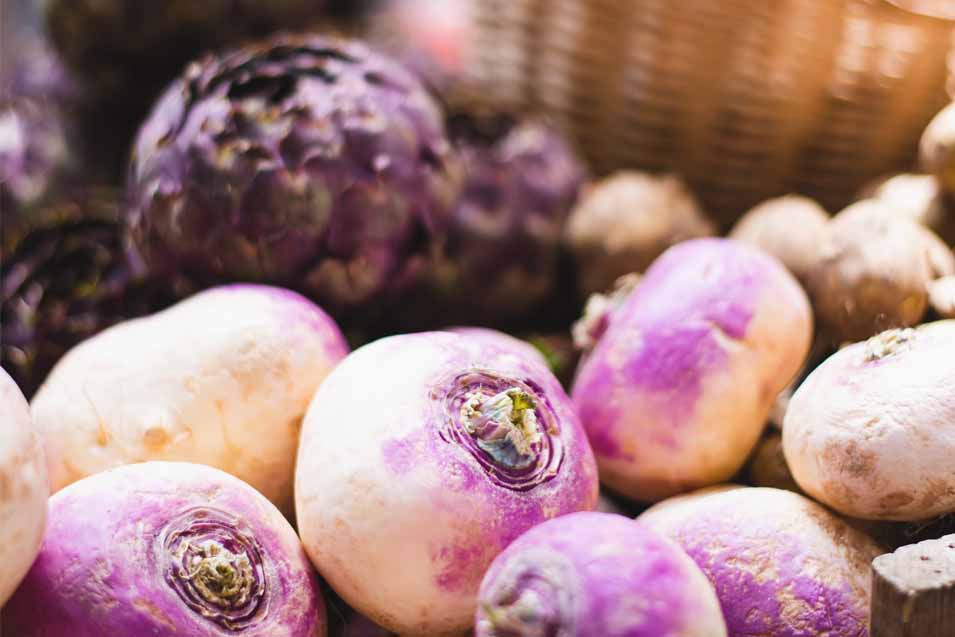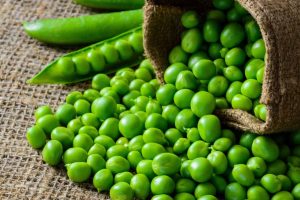Rutabagas? What are they? Are they good for you? And, more importantly, can dogs eat rutabagas? We have all the answers to your urgent rutabaga questions here! Keep reading and you’ll learn everything you need to know.
Nutrition
You may or may not be familiar with the rutabaga. This root vegetable goes by many names and is sometimes called a turnip, especially in Canada, Ireland, and parts of Britain. (Turnip usually refers to a white turnip elsewhere.) It’s called a Swedish turnip or a neep in Scotland. It’s also known as a swede in the UK and other Commonwealth countries.
Rutabagas are a cruciferous vegetable. In appearance they are brownish-white.
As a species, it seems to have originated as a hybrid between the cabbage and the turnip. It likely developed in the 16th century in northern Europe. There are reports of it growing wild in Sweden in 1620.
The roots can be eaten by humans in a variety of ways. It’s often served boiled and mashed, like potatoes. Other ingredients can be added for flavor. The leaves are also considered an edible vegetable. Both the roots and the tops are used to feed livestock. They can be fed in the winter or used as forage in the field at other times. Some Celtic countries have a tradition of carving the rutabaga roots into lanterns at Halloween, similar to pumpkins as Jack o’lanterns.
The rutabaga has been associated with food shortages in Germany and France because of WWI and WWII. It was eaten (and eaten and eaten) as a last resort during extreme hunger. As a result, some older people in these countries don’t have happy memories of this vegetable.
Nutrition Facts
Sources include: USDA
| Amount Per |
| 1 medium (386 g) |
| Calories 145 |
| % Daily Value* | ||||||
| Total Fat 0.6 g | 0% | |||||
| Saturated fat 0.1 g | 0% | |||||
| Cholesterol 0 mg | 0% | |||||
| Sodium 46 mg | 1% | |||||
| Potassium 1,177 mg | 33% | |||||
| Total Carbohydrate 33 g | 11% | |||||
| Dietary fiber 9 g | 36% | |||||
| Sugar 17 g | ||||||
| Protein 4.2 g | 8% | |||||
| Vitamin C | 160% | Calcium | 16% | |||
| Iron | 9% | Vitamin D | 0% | |||
| Vitamin B6 | 20% | Cobalamin | 0% | |||
| Magnesium | 19% | |||||
| *Percent Daily Values are based on a 2,000 calorie diet. Your daily values may be higher or lower depending on your calorie needs. | ||||||
Rutabagas provide some good nutrients. They are low in sodium and very low in saturated fat and cholesterol. They are a very good source of vitamin C, potassium, and manganese. They are also a good source of dietary fiber, thiamin, vitamin B6, calcium, magnesium, and phosphorus.
They do contain a lot of starch so a lot of the calories in rutabagas come from sugars.
Rutabagas have 9 percent protein, 5 percent fats, and 86 percent carbohydrates.
One cup of cubed rutabagas (170 grams) contains 66.3 calories. It has 14.9 total carbohydrates, 3.1 grams of dietary fiber, and 10.2 grams of sugars. However, it only has 0.4 grams of total fat. It has 96.9 mg of omega-3 fatty acids and 64.6 mg of omega-6 fatty acids. The one-cup serving has 2.2 grams of protein.
Rutabagas are also known for being high in antioxidants (vitamin C is an antioxidant). Antioxidants neutralize free radicals that can damage cells.
They also contain high amounts of a substance called glucosinolates. These are compounds that have antioxidant properties. They can reduce inflammation and may lower the risk of heart disease and some cancers such as colorectal, prostate, and breast cancer.
Eating foods that are high in antioxidants, such as rutabagas, may help prevent premature aging https://www.healthline.com/nutrition/rutabagas#TOC_TITLE_HDR_4.
The high dietary fiber in rutabagas are also good for bowel health. They are high in insoluble fiber – the kind of fiber that does not dissolve in water. This kind of fiber helps promote regularity and adds bulk to the stool. Fiber also feeds healthy gut bacteria and promotes a healthy microbiome. This may help prevent colorectal cancer, diabetes, and heart disease.
The fiber in rutabagas also promotes feelings of fullness which can help with weight loss.
Not everyone likes rutabagas. Some individuals can have genes affecting their taste receptor that detects the presence of glucosinolates in rutabagas. These individuals will find rutabagas to be very bitter. For other people who may only have one copy of this gene, rutabagas may not taste noticeably bitter or not too bitter to eat. Watercress, mustard greens, turnips, broccoli, and horseradish have the same glucosinolates.
There is one caution about rutabagas. Like some other cruciferous vegetables, they seem to be goitrogenic. This means that if you are hypothyroid (low thyroid), they appear to worsen the condition.
Can dogs have rutabagas?
Yes, most dogs can eat a small amount of rutabagas occasionally. They are nutritious and their fiber is beneficial for your dog’s digestive health.
However, if your dog has low thyroid or autoimmune thyroiditis, you should avoid giving him rutabagas. Rutabagas are one of the vegetables associated with worsening low thyroid issues. They are goitrogenic meaning that they can affect your dog’s thyroid gland. If your dog has a thyroid issue, talk to your veterinarian about which foods it is safe to share with him. In general, most cruciferous vegetables are goitrogenic (broccoli, brussel sprouts, kale, cabbage, cauliflower).
Otherwise, most dogs should be able to eat a moderate amount of rutabagas. Dogs can have them either raw or cooked. If you give them to your dog raw, you should cut them into small pieces first.
Be sure to wash the rutabaga well. As a root vegetable, dirt can cling to the rutabaga and even get under the skin. You can cut off the top and bottom of the rutabaga and peel it before using it.
There are many ways to cook rutabagas. They are easy to boil and mash, for example. When giving them to your dog, don’t use salt or other seasonings.
How many rutabagas can you give your dog?
Rutabagas are low in calories. A cup of cubed rutabagas only has about 66 calories. However, they are high in dietary fiber. Too much at one time can be challenging for your dog, especially if he has never had them before.
Too much fiber at one time can produce bloating, gas, stomach rumblings, and diarrhea.
Depending on your dog’s size, you can give him ¼ cup to ½ cup of rutabagas. Cooked rutabagas will probably be easier for him to digest at first. Try adding a little to your dog’s regular dinner.
It’s always a good idea to introduce a new food in small amounts at first. If your dog does well with a small amount of rutabagas, you can give him a little more the next time.
How often can you give your dog rutabagas?
If your dog likes rutabagas and doesn’t have any digestive problems after eating them, you could give them once or twice per week. As long as your dog doesn’t have any thyroid problems, they are quite healthy and full of beneficial nutrients.
Conclusion
Rutabagas are not widely eaten in the North America but you can usually find them in grocery stores. They are a healthy root vegetable and you can share them with your dog in moderate amounts. The only dogs who should avoid them are dogs with low thyroid. They are easy to prepare since they can be fed boiled and mashed. You can even give them to your dog raw as long as you cut them up in small pieces.






